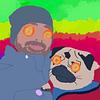Take a photo of a barcode or cover
informative
reflective
medium-paced
fast-paced
challenging
dark
informative
reflective
sad
medium-paced
Incredibly well researched and in depth overview of the 1948 Nakba. Absolute must read if you want a harrowing vignette of an important piece of Palestinian history:
Content Warning: do not read if you need to avoid hearing grisly details of atrocities.
.
.
.
.
.
.
This book was not easy reading. It chronicles the Nakba, or the catastrophic social devastation, mass murder, and mass displacement conducted by Israel against Palestinians beginning in 1948. As a whole, it is a horrific chapter of global history that left deep scars on an entire people, even while it continues in various forms up to today. Most striking was the utter brutality of the various Israeli military groupings organizing pogroms, who would line up Palestinian villagers in front of their towns and gleefully murder whole swathes of them as public displays. Scenes of pure terror: piles of bodies, torture, keeping Palestinians caged for days without food and water. The rapes, including of children, are particularly monstrous in their frequency and depravity.
It is difficult to come away from this book with an impression of the early Zionist movement as anything but evil. The state of Israel’s current (October 2023) sadistic campaign of ethnic cleansing in Gaza continues this legacy, adding atrocity after atrocity on an unthinkable scale.
Here is one scene—not even the most horrific—from the Nakba. Again, extreme content warning.
“On 9 April 1948, Jewish forces occupied the village of Deir Yassin. It lay on a hill west of Jerusalem, eight hundred metres above sea level and close to the Jewish neighbourhood of Givat Shaul. The old village school serves today as a mental hospital for the western Jewish neighbourhood that expanded over the destroyed village.
As they burst into the village, the Jewish soldiers sprayed the houses with machine-gun fire, killing many of the inhabitants. The remaining villagers were then gathered in one place and murdered in cold blood, their bodies abused while a number of the women were raped and then killed.
Fahim Zaydan, who was twelve years old at the time, recalled how he saw his family murdered in front of his eyes:
They took us out one after the other; shot an old man and when one of his daughters cried, she was shot too. Then they called my brother Muhammad, and shot him in front us, and when my mother yelled, bending over him – carrying my little sister Hudra in her hands, still breastfeeding her – they shot her too.
Zaydan himself was shot, too, while standing in a row of children the Jewish soldiers had lined up against a wall, which they had then sprayed with bullets, ‘just for the fun of it’, before they left. He was lucky to survive his wounds.
Recent research has brought down the accepted number of people massacred at Deir Yassin from 170 to ninety-three. Of course, apart from the victims of the massacre itself, dozens of others were killed in the fighting, and hence were not included in the official list of victims. However, as the Jewish forces regarded any Palestinian village as an enemy military base, the distinction between massacring people and killing them ‘in battle’ was slight. One only has to be told that thirty babies were among the slaughtered in Deir Yassin to understand why the whole ‘quantitative’ exercise – which the Israelis repeated as recently as April 2002 in the massacre in Jenin – is insignificant. At the time, the Jewish leadership proudly announced a high number of victims so as to make Deir Yassin the epicentre of the catastrophe – a warning to all Palestinians that a similar fate awaited them if they refused to abandon their homes and take flight.” (p. 90-91)
Thankfully for all of us, Palestinians continue to resist genocide. A just future will see a free Palestine, with an end to the occupation and colonization, the dismantling of the apartheid wall, recognition of the fundamental and equal rights of Palestinians, and the right of return to the millions of displaced refugees and their descendants.
.
.
.
.
.
.
This book was not easy reading. It chronicles the Nakba, or the catastrophic social devastation, mass murder, and mass displacement conducted by Israel against Palestinians beginning in 1948. As a whole, it is a horrific chapter of global history that left deep scars on an entire people, even while it continues in various forms up to today. Most striking was the utter brutality of the various Israeli military groupings organizing pogroms, who would line up Palestinian villagers in front of their towns and gleefully murder whole swathes of them as public displays. Scenes of pure terror: piles of bodies, torture, keeping Palestinians caged for days without food and water. The rapes, including of children, are particularly monstrous in their frequency and depravity.
It is difficult to come away from this book with an impression of the early Zionist movement as anything but evil. The state of Israel’s current (October 2023) sadistic campaign of ethnic cleansing in Gaza continues this legacy, adding atrocity after atrocity on an unthinkable scale.
Here is one scene—not even the most horrific—from the Nakba. Again, extreme content warning.
“On 9 April 1948, Jewish forces occupied the village of Deir Yassin. It lay on a hill west of Jerusalem, eight hundred metres above sea level and close to the Jewish neighbourhood of Givat Shaul. The old village school serves today as a mental hospital for the western Jewish neighbourhood that expanded over the destroyed village.
As they burst into the village, the Jewish soldiers sprayed the houses with machine-gun fire, killing many of the inhabitants. The remaining villagers were then gathered in one place and murdered in cold blood, their bodies abused while a number of the women were raped and then killed.
Fahim Zaydan, who was twelve years old at the time, recalled how he saw his family murdered in front of his eyes:
They took us out one after the other; shot an old man and when one of his daughters cried, she was shot too. Then they called my brother Muhammad, and shot him in front us, and when my mother yelled, bending over him – carrying my little sister Hudra in her hands, still breastfeeding her – they shot her too.
Zaydan himself was shot, too, while standing in a row of children the Jewish soldiers had lined up against a wall, which they had then sprayed with bullets, ‘just for the fun of it’, before they left. He was lucky to survive his wounds.
Recent research has brought down the accepted number of people massacred at Deir Yassin from 170 to ninety-three. Of course, apart from the victims of the massacre itself, dozens of others were killed in the fighting, and hence were not included in the official list of victims. However, as the Jewish forces regarded any Palestinian village as an enemy military base, the distinction between massacring people and killing them ‘in battle’ was slight. One only has to be told that thirty babies were among the slaughtered in Deir Yassin to understand why the whole ‘quantitative’ exercise – which the Israelis repeated as recently as April 2002 in the massacre in Jenin – is insignificant. At the time, the Jewish leadership proudly announced a high number of victims so as to make Deir Yassin the epicentre of the catastrophe – a warning to all Palestinians that a similar fate awaited them if they refused to abandon their homes and take flight.” (p. 90-91)
Thankfully for all of us, Palestinians continue to resist genocide. A just future will see a free Palestine, with an end to the occupation and colonization, the dismantling of the apartheid wall, recognition of the fundamental and equal rights of Palestinians, and the right of return to the millions of displaced refugees and their descendants.
challenging
emotional
informative
sad
dark
informative
slow-paced
A simple review for now: it is indeed significant to share the forgotten, or rather omitted story of the Palestinian struggle for freedom. Step by step we’ll see them free. #Resolution194
challenging
dark
informative
sad
tense
medium-paced
dark
emotional
hopeful
informative
reflective
sad
medium-paced
challenging
dark
reflective
sad
tense
medium-paced





